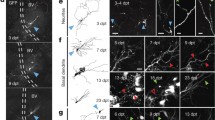Abstract
Neuroblasts taken from the developing central net vous system (CNS) can survive and later develop in the lesioned brain of adult recipients. These implanted neuroblasts develop many normal morphological and functional characteristics and, experimentally, substitute for intrinsic neurons. The rat striato-nigral system has been used as a model in which to study the ability of fetal neuroblasts to restore lesioned connections and promote functional recovery in brain lesioned animals. Tissue was obtained from the striatum and substantia nigra region either from E14–15 rat or mouse fetuses, or from 6–8 week old human fetal brain fragments, and implanted into the striatum or substantia nigra of rats previously subjected to neurotoxic lesions at one site or the other. Implanted neurons established extensive and highly specific connections with host cells; and in turn, the striatal implants received connections from all major afferent systems that normally innervate the striatum. In fact, implanted human striatal and nigral neuroblasts showed a. remarkable capacity to grow axons along major myelinated pathways and to reach distant target areas. Extensive axonal projections from striatal cells implanted into the lesioned striatum were seen along the internal capsule and the cerebral peduncle to the nigra and as far as the spinal cord (a distance of about 20 mm). From the human nigral cells implanted into the lesioned nigra, axons grew along the medial forebrain bundle and the internal capsule to reinnervate large parts of the striatal complex and parts of the frontal cortex (a. distance of about l0 mm). These results show that implanted fetal neuroblasts have the capacity to reconstruct specific circuitry over long distances in the lesioned adult brain.
Similar content being viewed by others
References
Björklund A and Lindvall O (1979) Regeneration of normal terminal innervation of the globus pallidus by colaterals from the nigro-striatal pathway. Brain Res 171: 271–293
Björklund A and Wiklund L (1980) Mechanism of regrowth of the bulbospinal serotonin system following 5,6-dihydrotryptamine induced axotomy. Brain Res 191: 109–127
Caroni P and Schwab ME (1988) Antibody against myelin-associated inhibitor of neurite growth neutralises non-permissive subsatrate properties of CNS white matter. Neuron 1: 85–96
David S and Aguayo AJ (1981). Axonal elongation into peripheral nervous system “bridges” after central nervous system injury in adult rats. Science 214: 931–933
Fawcett JW (1992). Factors responsible for the failure of structural repair in the central nervous system. In: Neurodegeneration. Eds AJ Hunter and M Clark. Academic Press, London. pp 81–96
Floeter MK and Jones EJ (1984). Connections made by transplants to the cerebral cortex of rat brains damaged in utero. J Neuroscience 4: 141–150
Hankin MH and Lund RD (1987) Role of target in directing the outgrowth of retinal axons: transplants reveal surface-related and surface-independent cues. J Comp Neurol 263: 455–466
Jakeman LB and Reier PJ (1991). Axonal projections between fetal spinal cord transplants and the adult rat spinal cord: a neuroanatomical tracing study of local interactions. J Comp Neurol 307:311–334
Schnell L and Schwab ME (1990). Axonal regeneration in the rat spinal cord produced by an antibody against myelin associated neurite growth inhibitors. Nature 343: 269–272
Schwab ME (1990). Myelin-associated inhibitors of neurite growth and regeneration in the CNS. Trends Neurosci 13: 452–455
Stanfield BB and O'Leary DDM (1985). Fetal occipital cortical neurones transplanted to the rostral cortex can extend and manintain a pyramidal tract axon. Nature 313: 135–136
Wictorin K, Clarke DJ, Bolam JP and Björklund A (1990). Fetal striatal neurons grafted into the ibotenate lesioned adult striatum: efferent projections and synaptic contacts in the host globus pallidus. Neuroscience 37: 301–315
Wictorin K, Brundin P, Guslavii B, Lindvall O, Björklund A (1990) Reformation of long axon pathways in adult rat central nervous system by human forebrain neuroblasts. Nature 347: 556–558
Wictorin K, Lagenauer CF, Lund RD and Björklund A (1991) Efferent projections to the host brain from intrastriatal striatal mouse-to-rat grafts: time course and tissue-type specificity as revealed by a mouse specific neuronal marker. Eur J Neurosci 3: 86–101
Wictorin K, Brundin P, Sauer H, Lindvall O and Björklund A (1992) Long distance directed axonal growth from human dopaminergic lesioned adult rats. J Comp Neurol 323: 475–494
Wictorin K and Björklund A (1992) Axon outgrowth from grafts of human embryonic spinal cord in the lesioned adult rat spinal cord. NeuroReport 3: 1045–1048
Wiklund L and Björklund A (1980) Mechanisms of regrowth in the bulbospinal serotonin system following 5,6-dihydrotryptamine induced axotomy. II. Fluorescence histochemical observations. Brain Research 191: 129–160
Author information
Authors and Affiliations
Rights and permissions
About this article
Cite this article
Björklund, A. Long distance axonal growth in the adult central nervous system. J Neurol 242 (Suppl 1), S33–S35 (1994). https://doi.org/10.1007/BF00939239
Issue Date:
DOI: https://doi.org/10.1007/BF00939239




